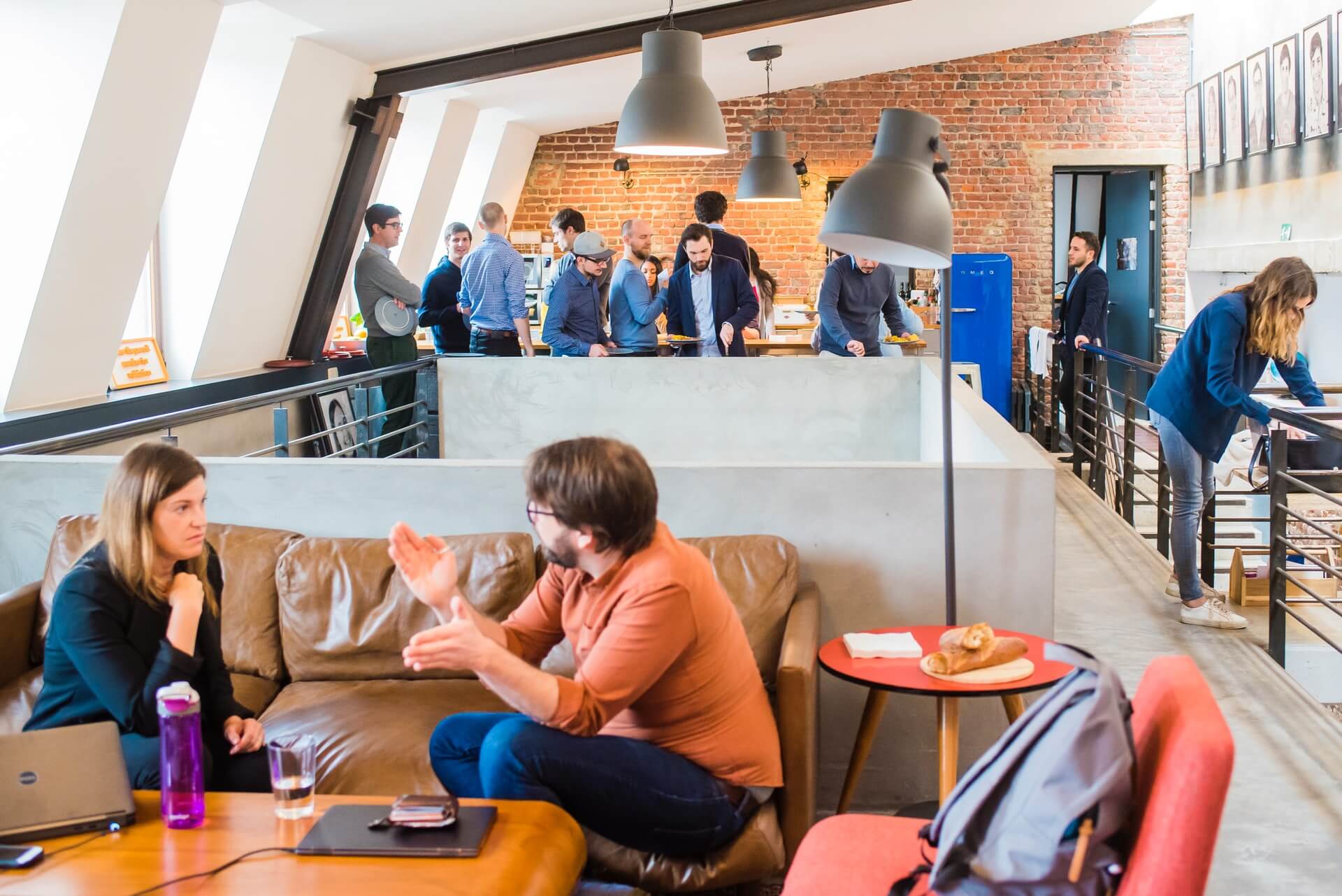Key takeaways
- Millennials and Gen Z will soon make up the majority of the workforce, and they have different values from the generations before them. To attract and retain quality workers, companies have to understand what these employees want from employers.
- Three of the top concerns among the new workforce are sustainability, inclusion, and mental health in the workplace.
- Physical office space is the perfect tool to showcase your company’s ethos and differentiate it from the competition. The office serves as irrefutable evidence that your business “walks the walk” when it comes to the principles that younger generations want to see in the workplace.
Changes to the workforce
The global workforce is in the midst of a great shift. Boomers are retiring, and the rise of millennials and Gen Z in the workplace is bringing rapid changes to companies’ recruitment and retention methods.
Nearly 90% of human resources professionals agree that recruitment is increasingly like marketing, and the key to effective marketing is understanding your audience.
To sell your prospects on the benefits of investing their talent in your company and staying for the long haul, you have to know what they want in an employer. Fortunately, you don’t have to guess what workers are looking for. Millennial and Gen Z employees are vocal about their values and expectations. They want to work for companies with:
- Environmentally responsible practices and sustainability initiatives. Over 80% want to see their employers commit to visible climate actions, such as banning single-use plastics in the office.
- A positive, inclusive company culture. 52% of employees aren’t happy with their company’s progress toward diversity and inclusion, and they plan to leave these jobs within two years.
- A focus on mental health. One of the top reasons millennials and Gen Zs reported leaving a job was “feeling the workplace was detrimental to their mental health.”
In its 2022 survey of millennials and Gen Z, Deloitte found that “those who are satisfied with their employers’ societal and environmental impact, and their efforts to create a diverse and inclusive culture, are more likely to want to stay with their employer for more than five years.” They also noted that two out of five workers had rejected a job because it didn’t align with their values.
If your company wants to continue hiring — and keeping — top talent, it’s essential to adapt quickly to meet the needs of these two up-and-coming generations of workers.
The office as your secret weapon
When it comes to attracting quality job candidates and improving retention rates, companies with physical office spaces have an edge over their fully remote competitors. It’s much more difficult for a company without an office to create a cohesive, values-first work culture and establish the type of visible climate, inclusion, and well-being actions that resonate with younger workers.
Companies with physical office spaces have an edge over their fully remote competitors.
Employers that embrace the office as the key to managing recruitment and retention have the perfect canvas on which to market their company’s ethos and create a strong employer brand statement that’s attractive to potential new hires.
The modern office is essentially a product, and it can be an important differentiator that makes your company stand out. “Look at your employees as modern-day consumers,” Mike Palladino, a member of the Strategic Partnerships team at Density, says. “Modern-day consumers expect a personalized experience to consume anything — so make sure that you’re trying to personalize [the office] to them.”
That means aligning your office design and amenities with the expectations of the new workforce, such as sustainability, inclusion, and well-being. There are countless opportunities to turn your office space into an effective marketing tool to attract new employees and improve your retention strategy.
How to highlight important values in the office with amenities and design
Below are several ways companies can improve talent acquisition and retention by aligning their workspaces with each of the principles that are most important to the new workforce.
Sustainability
- Office-wide initiatives: Deloitte’s survey revealed that younger generations value “highly visible climate actions…such as banning single-use plastic products.” This type of green challenge allows employees to get personally involved with the company’s efforts to be more sustainable. It creates a shared purpose and shows employees that your company is serious about its environmentally conscious ethos.
- Automated HVAC and lighting: Typical energy consumption from heating, cooling, and lighting an office comes with a big carbon footprint. Automating your HVAC and lighting ensures you’re only using these services in areas occupied by people. It reduces overall consumption and the greenhouse gases and pollution that comes with it. In addition to earning your company sustainability points with employees, automating these utilities saves money.
- Eco-friendly materials: When replacing furniture and decor or renovating a space, use it as an opportunity to source eco-friendly materials such as bamboo flooring, organic fabrics, and furniture made from recycled materials. Choosing greener materials is kinder to the planet, enhances biophilic design, and reduces the risk of VOCs polluting the air in the office and potentially making people sick.
Well-being
- Biophilic design: “Biophilia” means “love of life or living things.” Biophilic design celebrates life by incorporating natural elements into office design. Features such as outdoor work areas, indoor plants, plenty of natural light, and natural building materials create a built environment that reduces stress, improves focus, and promotes mental well-being. It creates an office space where workers can be happy, comfortable, and productive.
- Wellness rooms: Work stress is seemingly inescapable, but your company can help ease the impact by providing wellness rooms in the office. A wellness room is a dedicated quiet area where employees can go when they need to decompress from the hustle and bustle of the office. These areas are often designated tech-free, providing workers a haven to take a break from the barrage of notifications and the nonstop hum of electronics.
- Healthier workplace options: Sit-to-stand desks, ergonomic office furniture, healthy snacks and lunch options, and in-office yoga classes are just a few examples of ways to offer employees healthier workplace options. Introducing these amenities show employees that your company is invested in their overall health and well-being.
Inclusion
- Quiet areas: A quiet area in the office is where workers can do their focused work without pressure to interact with colleagues. This is an important feature for companies that want to be inclusive of neurodivergent employees. For workers who have trouble concentrating or being surrounded by people, a dedicated quiet area provides a space to do their best work.
- Gender-neutral bathrooms: Choosing the “right” bathroom has become a political issue and creates a lot of stress for trans and nonbinary workers. Gender-inclusive bathrooms remove the pressure of choosing, and it protects employees from uncomfortable reactions from colleagues.
- Use the LLI model: “Listen, learn, implement” is a model created by Chiara Smith, a racial health equity expert, to help organizations create safe, inclusive spaces for BIPOC workers. “We must listen to the experiences of those most impacted, learn from the mistakes of the past, and implement as suggested by those most impacted,” Chiara explains. Adopting the LLI model can help improve your company’s retention by building a workplace where everyone is comfortable being themselves.
How to make the most of your office to attract and retain talent
Now that you understand what modern workers want from employers and how your office represents your brand, the next step is to recognize how your space is currently performing. This can help you discover valuable opportunities to showcase your company’s ethos in ways that will attract job seekers and inspire long-term commitment to your business.
Employee feedback and utilization data are two excellent tools for uncovering your office’s full potential. What’s working for your team? What areas do they feel need improvement? How are they naturally using space for informal chats and socializing? Which areas of the office are underutilized? Collecting this type of information gives you an overview of how your space is performing and identifies opportunities for improvement.
Example of how to use feedback and utilization to optimize the office
Let’s say your employee survey reveals that workers find the office environment noisy, distracting, and stressful. Your workplace team recognizes this as an opportunity to support one of your employees’ top priorities — better mental health in the workplace.
They want to introduce biophilic design elements such as greenery throughout the office space, and they identify a wellness room as an essential amenity for employee well-being. But how do you find the right space to create a wellness room?
While offices rarely have empty rooms with no dedicated purpose, they often have areas that aren’t performing well. Your building utilization data reveals several rooms in the office that see little action, so your team can select the best one to repurpose into a wellness space.
Once the new wellness room is in place, you can monitor its success by seeing how often employees use the space and what they have to say about it. Changes like this are all about improving recruitment and retention, and it’s hard to overstate the positive impact that this type of proactive change has on employees.
A prime opportunity
The landscapes of talent acquisition and employee retention are in a state of flux as new generations transition into the workforce. These workers have different values and priorities that employers must recognize and accommodate to land quality job candidates and reduce expensive turnover. The physical office space offers a prime opportunity to demonstrate to younger workers that your company understands their needs and can adapt to meet them.




